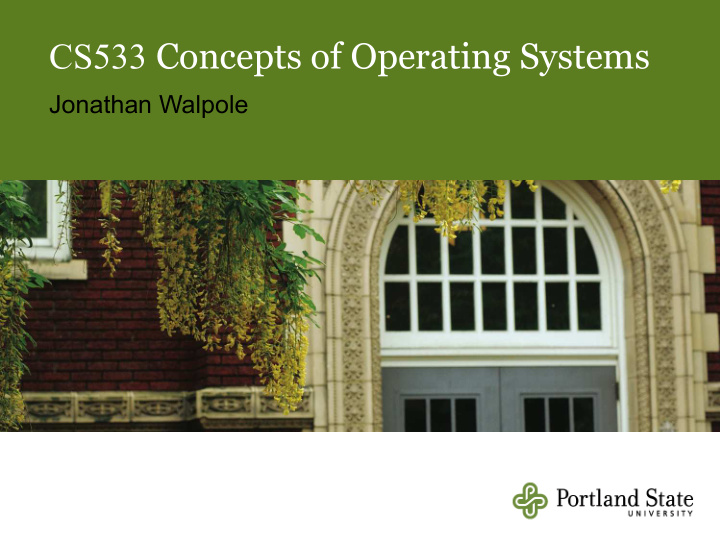



CS533 Concepts of Operating Systems Jonathan Walpole
SEDA: An Architecture for Well- Conditioned Scalable Internet Services
Overview What does well-conditioned mean? Internet service architectures - thread per request - thread pools - event driven The SEDA architecture Evaluation
Internet Services Wide variation in Internet load - the slashdot effect Wide variation in service requirements - must support static and dynamic content - with responsiveness and high availability Resource management challenge - supporting massive concurrency at a low cost
Well-Conditioned Services A well-conditioned service will not bog down under heavy load! As load increases response time should increase linearly Well-conditioned services require the right architectural approach SEDA = Staged Event-Driven Architecture
Architectural Alternatives 1. Thread per request architecture 2. Thread pool architecture 3. Event driven architecture
������������������������ � ����������������������������������������� ���������������������������������������� ������������������������������� Thread Per Request � �������������������������������� Create a new thread for each request Delete thread when request is complete Thread blocks during I/O Standard approach in RPC, Java RMI, DCOM
Super Market Analogy Hire a checkout clerk when a customer enters the store Fire the checkout clerk when the customer leaves the store Is this implementation of a super market service well-conditioned? How could we do better?
������������������������ �������������������������������������� Does This Work for Web Servers? � ��������������������
Why Does This Happen? Despite being easy to program, this approach suffers from: - excessive delay for thread creation - overhead of thread destruction - premature thrashing of CPU, memory, and cache, when load gets high - high context switch overhead - high memory costs for thread stack and TCB
Thread Pools Very similar structure, except - the number of threads is bounded - threads are created statically - threads are recycled after use - requests delayed when all threads in use Standard approach in Apache, IIS, Netscape ES, BEA Weblogic, IBM WebSphere, etc
Super Market Analogy Hire N permanent checkout clerks - each customer is assigned to a clerk - M clerks per cash register - clerks may need to queue to use register How does this approach perform during normal load and during overload? What happens if a customer has an unusual request?
Thread Pool Performance Mixed workloads can result in unfair delays Its difficult to identify problems or sources of bottlenecks when all threads look alike Its difficult to know how big the thread pool should be
������������������������ The Event-Driven Approach � ���������������������������������������� Request arrival is an event � ������������������������������������������ Events are handled by the execution of a function ������������������������������ - an event handler � ������������������������������������������ Event handlers are run sequentially and non-preemptively ����������������������������������� - using one thread per CPU
Super Market Analogy One checkout clerk per cash register Customers queue waiting for clerk Clerk completes work for one customer before starting work for the next Bottlenecks are easy to identify and fix - customer queues get too long at the problem register - customers can be moved from one queue to another
������������������������ ������������������������������ Does This Work for a Web Server? � ������������������������������
Event Driven Architectures What is good about them? - Robust in the face of load variation - High throughput - Potential for fine grain control
Event Driven Architectures Used in Flash, thttpd, Zeus, JAW, and Harvest SEDA extends the idea to expose load-related information and to simplify and automate dynamic load balancing and load shedding
SEDA’s Building Block – Stage
���������������������������������� � ������������������������������� � ����������������������������������� ��������������������������� Stages Connected by Event Queues � ������������������������������������������ ������������������������������� Event queues define the control boundaries and can be inspected!
���������������������������� � �������������������������������� � ���������������������������������������������������� Dynamic Resource Controllers ����������������������������������� � ������������������������������������������
��������������������������� Thread Pool Controller Performance
������������������������ Batching Controller Performance
��������������������������� Adaptive Load Shedding � ����������������������������������������������������� �������������������������������������������������� � ���������������������������������������������������� �������������� ��������������� � ����������� ����������������� ������������������ ������������ � ���������������� �������������� ������������������
Asynchronous I/O You need asynchronous I/O but its not always available form the OS! Asynchronous socket I/O - non-blocking socket calls used in readStage, writeStage, and listenStage Asynchronous file I/O - asynchronous file calls not available - had to fake it using a thread pool
������� ������������������������������� Haboob HTTP Server
������������������������������� Gnutella Packet Router
Conclusion The SEDA approach works well - it supports high concurrency - it is easy to program and tune - services are well-conditioned - introspection and self-tuning are supported
Recommend
More recommend